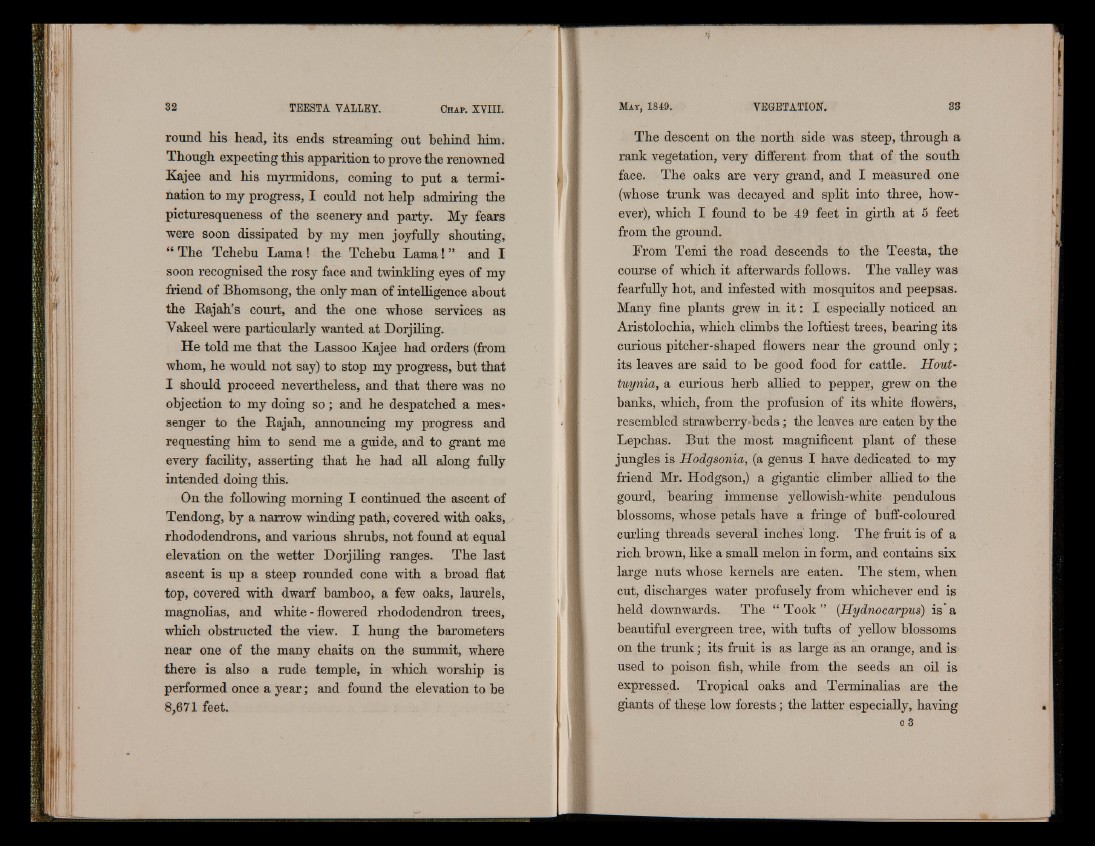
round his head, its ends streaming out behind him.
Though expecting this apparition to prove the renowned
Kajee and his myrmidons, coming to put a termination
to my progress, I could not help admiring the
picturesqueness of the scenery and party. My fears
were soon dissipated by my men joyfully shouting,
“ The Tchebu Lama! the Tchehu L am a !” and I
soon recognised the rosy face and twinkling eyes of my
friend of Bhomsong, the only man of intelligence about
the BajahJs court, and the one whose services as
Vakeel were particularly wanted at Doijiling.
He told me that the Lassoo Kajee had orders (from
whom, he would not say) to stop my progress, hut that
I should proceed nevertheless, and that there was no
objection to my doing s o ; and he despatched a messenger
to the Bajah, announcing my progress and
requesting him to send me a guide, and to grant me
every facility, asserting that he had all along fully
intended doing this.
On the following morning I continued the ascent of
Tendong, by a narrow winding path, covered with oaks,
rhododendrons, and various shrubs, not found at equal
elevation on the wetter Doijiling ranges. The last
ascent is up a steep rounded cone with a broad flat
top, covered with dwarf bamboo, a few oaks, laurels,
magnolias, and white - flowered rhododendron trees,
which obstructed the view. I hung the barometers
near one of the many chaits on the summit, where
there is also a rude temple, in which worship is
performed once a year; and found the elevation to be
8,671 feet.
The descent on the north side was steep, through a
rank vegetation, very different from that of the south
face. The oaks are very grand, and I measured one
(whose trunk was decayed and split into three, however),
which I found to be 49 feet in girth at 5 feet
from the ground.
From Temi the road descends to the Teesta, the
course of which it afterwards follows. The valley was
fearfully hot, and infested with mosquitos and peepsas.
Many fine plants grew in i t : I especially noticed an
Aristolochia, which climbs the loftiest trees, bearing its
curious pitcher-shaped flowers near the ground on ly ;
its leaves are said to be good food for cattle. Hout-
tuynia, a curious herb allied to pepper, grew on the
banks, which, from the profusion of its white flowers,
resembled strawberry-beds; the leaves are eaten by the
Lepchas. But the most magnificent plant of these
jungles is Hodg sonia, (a genus I have dedicated to my
friend Mr. Hodgson,) a gigantic climber allied to the
gourd, bearing immense yellowish-white pendulous
blossoms, whose petals have a fringe of buff-coloured
curling threads several inches long. The fruit is of a
rich brown, like a small melon in form, and contains six
large nuts whose kernels are eaten. The stem, when
cut, discharges water profusely from whichever end is
held downwards. The “ T o o k ” (Hydnocarpus) is a
beautiful evergreen tree, with tufts of yellow blossoms
on the tru n k ; its fruit is as large as an orange, and is
used to poison fish, while from the seeds an oil is
expressed. Tropical oaks and Terminalias are the
giants of these low forests; the latter especially, having